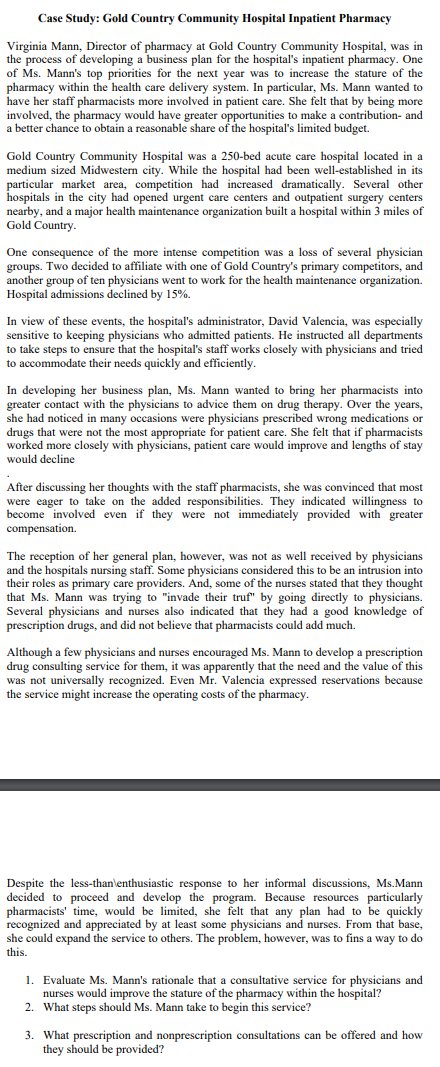
Case Study: Gold Country Community Hospital Inpatient Pharmacy Virginia Mann, Director of pharmacy at Gold Country Community Hospital, was in the process of developing a business plan for the hospital's inpatient pharmacy. One of Ms. Mann's top priorities for the next year was to increase the stature of the pharmacy within the health care delivery system. In particular, Ms. Mann wanted to have her staff pharmacists more involved patient care. She felt that by being more involved, the pharmacy would have greater opportunities to make a contribution- and a better chance to obtain a reasonable share of the hospital's limited budget. Gold Country Community Hospital was a 250-bed acute care hospital located in a medium sized Midwestern city. While the hospital had been well-established in its particular market area, competition had increased dramatically. Several other hospitals in the city had opened urgent care centers and outpatient surgery centers nearby, and a major health maintenance organization built a hospital within 3 miles of Gold Country One consequence of the more intense competition was a loss of several physician groups. Two decided to affiliate with one of Gold Country's primary competitors, and another group of ten physicians went to work for the health maintenance organization. Hospital admissions declined by 15%. In view of these events, the hospital's administrator, David Valencia, was especially sensitive to keeping physicians who admitted patients. He instructed all departments to take steps to ensure that the hospital's staff works closely with physicians and tried to accommodate their needs quickly and efficiently. In developing her business plan, Ms. Mann wanted to bring her pharmacists into greater contact with the physicians to advice them on drug therapy. Over the years, she had noticed in many occasions were physicians prescribed wrong medications or drugs that were not the most appropriate for patient care. She felt that if pharmacists worked more closely with physicians, patient care would improve and lengths of stay would decline After discussing her thoughts with the staff pharmacists, she was convinced that most were eager to take on the added responsibilities. They indicated willingness to become involved even if they were not immediately provided with greater compensation The reception of her general plan, however, was not as well received by physicians and the hospitals nursing staff. Some physicians considered this to be an intrusion into their roles as primary care providers. And, some of the nurses stated that they thought that Ms. Mann was trying to "invade their truf" by going directly to physicians. Several physicians and nurses also indicated that they had a good knowledge of prescription drugs, and did not believe that pharmacists could add much. Although a few physicians and nurses encouraged Ms. Mann to develop a prescription drug consulting service for them, it was apparently that the need and the value of this was not universally recognized. Even Mr. Valencia expressed reservations because the service might increase the operating costs of the pharmacy. Despite the less-than enthusiastic response her informal discussions, Ms.Mann decided to proceed and develop the program. Because resources particularly pharmacists' time, would be limited, she felt that any plan had to be quickly recognized and appreciated by at least some physicians and nurses. From that base, she could expand the service to others. The problem, however, was to fins a way to do this. 1. Evaluate Ms. Mann's rationale that a consultative service for physicians and nurses would improve the stature of the pharmacy within the hospital? 2. What steps should Ms. Mann take to begin this service? 3. What prescription and nonprescription consultations can be offered and how they should be provided? Case Study: Gold Country Community Hospital Inpatient Pharmacy Virginia Mann, Director of pharmacy at Gold Country Community Hospital, was in the process of developing a business plan for the hospital's inpatient pharmacy. One of Ms. Mann's top priorities for the next year was to increase the stature of the pharmacy within the health care delivery system. In particular, Ms. Mann wanted to have her staff pharmacists more involved patient care. She felt that by being more involved, the pharmacy would have greater opportunities to make a contribution- and a better chance to obtain a reasonable share of the hospital's limited budget. Gold Country Community Hospital was a 250-bed acute care hospital located in a medium sized Midwestern city. While the hospital had been well-established in its particular market area, competition had increased dramatically. Several other hospitals in the city had opened urgent care centers and outpatient surgery centers nearby, and a major health maintenance organization built a hospital within 3 miles of Gold Country One consequence of the more intense competition was a loss of several physician groups. Two decided to affiliate with one of Gold Country's primary competitors, and another group of ten physicians went to work for the health maintenance organization. Hospital admissions declined by 15%. In view of these events, the hospital's administrator, David Valencia, was especially sensitive to keeping physicians who admitted patients. He instructed all departments to take steps to ensure that the hospital's staff works closely with physicians and tried to accommodate their needs quickly and efficiently. In developing her business plan, Ms. Mann wanted to bring her pharmacists into greater contact with the physicians to advice them on drug therapy. Over the years, she had noticed in many occasions were physicians prescribed wrong medications or drugs that were not the most appropriate for patient care. She felt that if pharmacists worked more closely with physicians, patient care would improve and lengths of stay would decline After discussing her thoughts with the staff pharmacists, she was convinced that most were eager to take on the added responsibilities. They indicated willingness to become involved even if they were not immediately provided with greater compensation The reception of her general plan, however, was not as well received by physicians and the hospitals nursing staff. Some physicians considered this to be an intrusion into their roles as primary care providers. And, some of the nurses stated that they thought that Ms. Mann was trying to "invade their truf" by going directly to physicians. Several physicians and nurses also indicated that they had a good knowledge of prescription drugs, and did not believe that pharmacists could add much. Although a few physicians and nurses encouraged Ms. Mann to develop a prescription drug consulting service for them, it was apparently that the need and the value of this was not universally recognized. Even Mr. Valencia expressed reservations because the service might increase the operating costs of the pharmacy. Despite the less-than enthusiastic response her informal discussions, Ms.Mann decided to proceed and develop the program. Because resources particularly pharmacists' time, would be limited, she felt that any plan had to be quickly recognized and appreciated by at least some physicians and nurses. From that base, she could expand the service to others. The problem, however, was to fins a way to do this. 1. Evaluate Ms. Mann's rationale that a consultative service for physicians and nurses would improve the stature of the pharmacy within the hospital? 2. What steps should Ms. Mann take to begin this service? 3. What prescription and nonprescription consultations can be offered and how they should be provided







